
The Edmund Fowle House is a historic house and local history museum at 28 Marshall Street in Watertown, Massachusetts, USA. Built in 1772, it is the second-oldest surviving house in Watertown, and served as the meeting place for the Massachusetts Provincial Congress in the first year of the American Revolutionary War. Now owned by the local historic society, it was listed on the National Register of Historic Places in 1977.

Grand-Pré National Historic Site is a park set aside to commemorate the Grand-Pré area of Nova Scotia as a centre of Acadian settlement from 1682 to 1755, and the British deportation of the Acadians that happened during the French and Indian War. The original village of Grand Pré extended four kilometres along the ridge between present-day Wolfville and Hortonville. Grand-Pré is listed as a World Heritage Site and is the main component of two National Historic Sites of Canada.

The Hyland House Museum or Hyland–Wildman House is a historic house museum at 84 Boston Road in Guilford, Connecticut. Built in 1713, it is one of the town's best-preserved houses of that period. It has been open to the public as a museum since 1918, under the auspices of a local historic preservation group. It was added to the National Register of Historic Places in 1976. The house features Colonial-era furnishings and artifacts.

The Joseph Willis House is a historic colonial house located at 28 Worcester Street in Taunton, Massachusetts. Built in 1688, it is the city's oldest surviving building, and one of the oldest in the state.

The Meigs–Bishop House is a historic house at 45 Wall Street in Madison, Connecticut. With a construction history dating to about 1690, it is one of the town's oldest surviving buildings. It was listed on the National Register of Historic Places in 1988. It is now used for commercial purposes.

The John Tyler House is a historic house at 242–250 East Main Street in Branford, Connecticut. Built about 1710, it is one of the town's few surviving 18th-century residences, and a good example of late First Period architecture. The house was listed on the National Register of Historic Places in 1988.
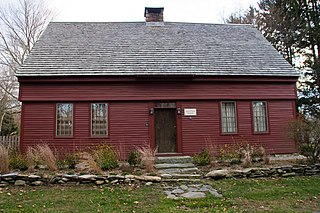
The Jonathan Murray House is a historic house at 76 Scotland Road in Madison, Connecticut. Built about 1690, it is one of a handful of 17th-century houses surviving in the state. The house was listed on the National Register of Historic Places in 1982.

The Thomas Burgis II House is a historic house at 85 Boston Street in Guilford, Connecticut. With a construction history dating to about 1735, it is one of Guilford's finest and best-documented colonial-era houses, standing on property with a documented history to the 17th century. The house was listed on the National Register of Historic Places in 2000.

The Griswold House is a historic house museum at 171 Boston Street in Guilford, Connecticut. Built about 1764, it is a well-preserved example of New England colonial architecture, and was listed on the National Register of Historic Places in 1975. The Guilford Keeping Society operates the house as the Thomas Griswold House Museum. The museum includes the late 18th century period New England saltbox house, a historic blacksmith shop, a barn with farm tools and implements, two corn cribs and a Victorian era three seat outhouse. The museum is open seasonally from June through October on a limited number of days each week.

The Nathaniel Hempstead House, also known as the Old Huguenot House, is a historic house museum on Hempstead Street in New London, Connecticut. Built about 1759, it is an architecturally unusual stone house with a gambrel roof, a style not otherwise seen in the city. Because of its unusual form, it was thought to have been built by French Huguenot immigrants at an earlier date. The house is owned by Connecticut Landmarks, along with the adjacent Joshua Hempsted House, operating the pair as the Hempstead Houses museum. The house was listed on the National Register of Historic Places on December 2, 1970.
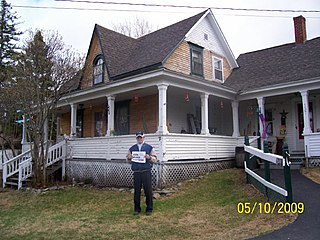
The Isaie and Scholastique Martin House at 137 Saint Catherine Street in Madawaska, Maine, is a well-preserved example of an Acadian log house built following traditional regional techniques. The house was listed on the National Register of Historic Places in 2009.

The John Glover House is a historic house at 53 Echo Valley Road in Newtown, Connecticut, USA. Built about 1708 by an early town settler, it is a remarkably well-preserved example of 18th-century residential architecture, owned for generations by a locally prominent farming family. The house was listed on the National Register of Historic Places in 2001.
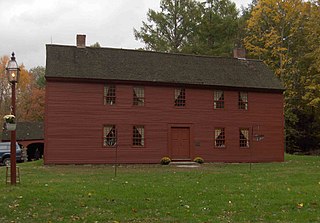
The Strong House, now the Strong-Porter Museum, is a historic house museum at 2382 South Street in Coventry, Connecticut. It is a 2+1⁄2-story wood-frame structure, five bays wide, with a center entry and two interior chimneys. The oldest portion of the house is estimated to date to 1710, early in the period of Coventry's settlement, and retains a significant number of period features. The house was listed on the National Register of Historic Places in 1988. It is now owned and operated by the Coventry Historical Society as a museum. In addition to exhibits in the house about local history, visitors can tour the carpenter shop, 19th century privy, carriage sheds and barn.

The Pelatiah Leete House is a historic house at 575 Leete's Island Road in Guilford, Connecticut, United States. Built in 1710 by Pelatiah Leete, it is the oldest surviving house associated with the locally prominent Leete family, who were among the founders of the New Haven Colony. The house was listed on the National Register of Historic Places in 1974.
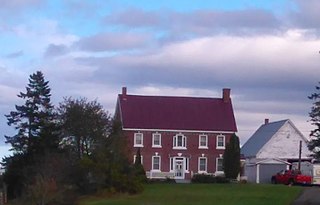
The Chapman House is a National Historic Site of Canada located on Mount Whatley Road in Fort Lawrence, Nova Scotia consisting of a Georgian style brick house and the lot on which it sits.
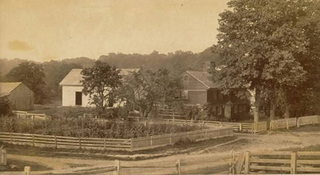
The John Hollister House is a historic house at 14 Tryon Street in the South Glastonbury village of Glastonbury, Connecticut. Built about 1675, it is the town's oldest surviving colonial structure, built by one of its early settlers. It was listed on the National Register of Historic Places in 1972.
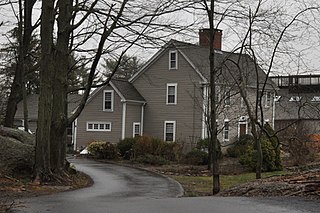
The Jared Eliot House is a historic house at 88 Mulbery Farms Road in Guilford, Connecticut. Built in 1723, it is a well-preserved example of period residential architecture, built by Rev. Jared Eliot, an influential figure in the social and economic life of the community. The house was listed on the National Register of Historic Places in 1985.
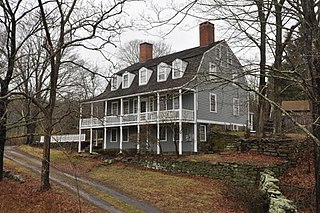
The Medad Stone Tavern is a historic house museum at 191 Three Mile Course in Guilford, Connecticut. Built in 1803 but never actually used as a tavern, it is well-preserved example of early 19th-century Federal period architecture. It is now maintained as a museum by a local historical society. It was listed on the National Register of Historic Places in 2009.

The Elisha Pitkin House is a historic house at 173 High Woods Drive in Guilford, Connecticut. With a construction history estimated to date to 1690, it is one of Connecticut's small number of surviving 17th-century buildings. It was moved to this site in 1955 from its original site in East Hartford, and was listed on the National Register of Historic Places in 1979.

The Sabbathday House, also known as the Daniel Bowen House is a historic house at 19 Union Street in Guilford, Connecticut. Built about 1735, it is one two surviving houses in the town built for the purpose of sheltering church-going families between morning and afternoon services. The house was listed on the National Register of Historic Places in 1975.
























